

SaaS Metrics 2.0 – A Guide to Measuring and Improving what Matters. SaaS Economics - Part 1: The SaaS Cash Flow Trough. This post provides SaaS entrepreneurs with an Excel spreadsheet model and graphs that show the cash flow trough that happens to SaaS, or other subscription/recurring revenue businesses that use a sales organization.
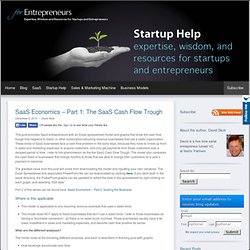
These kinds of SaaS businesses face a cash flow problem in the early days, because they have to invest up front in sales and marketing expenses to acquire customers, and only get payments from those customers over a delayed period of time. I refer to this phenomenon as the the SaaS Cash Flow Trough. The model also compares the cash flows of businesses that charge monthly to those that are able to charge their customers for a year’s payment in advance.
The greatest value from this post will come from downloading the model and inputting your own variables. The Excel Spreadsheet and associated PowerPoint file can be downloaded by clicking here. Part 2 of this series can be found here: SaaS Economics – Part 2: Scaling the Business. Where is this applicable The Cash Flow Trough. How to estimate Lifetime Value; Sample cohort analysis. In many businesses, repeat purchase behavior is a key driver of value.
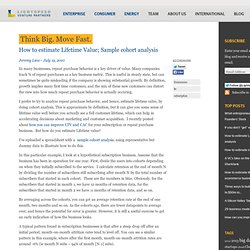
Many companies track % of repeat purchases as a key business metric. This is useful in steady state, but can sometimes be quite misleading if the company is showing substantial growth. By definition, growth implies many first time customers, and the mix of these new customers can distort the view into how much repeat purchase behavior is actually occuring. I prefer to try to analyze repeat pruchase behavior, and hence, estimate lifetime value, by doing cohort analysis. This is approximate by definition, but it can give you some sense of lifetime value well before you actually see a full customer lifetime, which can help in accelerating decisions about marketing and customer acquisition. I’ve uploaded a spreadsheet with a sample cohort analysis, using representative but dummy data to illustrate how to do this. Financial planning for SaaS Startups: Q&A with Christoph Janz. I quit my day job with my friend Igor I started a new company called elastic.io, a solution that helps people connect cloud API’s without programming.
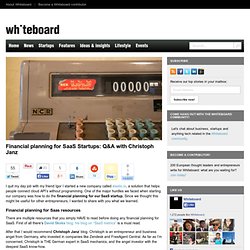
One of the major hurdles we faced when starting our company was how to do the financial planning for our SaaS startup. Since we thought this might be useful for other entrepreneurs, I wanted to share with you what we learned. Financial planning for Saas resources There are multiple resources that you simply HAVE to read before doing any financial planning for SaaS. First of all there’s David Skoks blog: his blog on “SaaS metrics” is a must read. After that I would recommend Christoph Janz‘ blog. In March 2012, Christoph published a couple of blog posts about financial planning for SaaS, which we studied intensely. This sample financial plan is pretty detailed and you can read it on Christoph’s blog, so I won’t go into it again, but after we studied it, we still had a few unanswered questions about it. Financial planning for SaaS startups. A few people who read my recent post about financial planning asked if I could provide an example for a good financial plan, so I'd like to post one here.
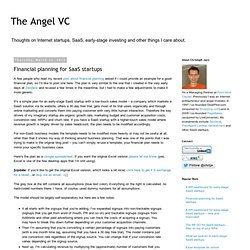
The plan is very similar to the one that I created in the very early days at Zendesk and re-used a few times in the meantime, but I had to make a few adjustments to make it more generic. It's a simple plan for an early-stage SaaS startup with a low-touch sales model – a company which markets a SaaS solution via its website, offers a 30 day free trial, gets most of its trial users organically and through online marketing and converts them into paying customer with very little human interaction. Therefore the key drivers of my imaginary startup are organic growth rate, marketing budget and customer acquisition costs, conversion rate, ARPU and churn rate.
If you have a SaaS startup with a higher-touch sales model where revenue growth is largely driven by sales headcount, the plan needs to be modified accordingly. Avoiding Parkinson's Law of Triviality in your financial plan. Startups and financial models for SAAS companies. The other day I met with an entrepreneur I was advising as he prepared to raise his next round of funding.
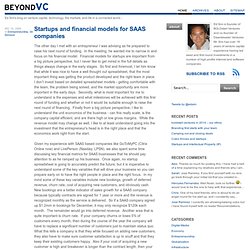
In the meeting, he wanted me to narrow in and focus on his financial model. Financial models for startups are important from a big picture perspective, but I never like to get mired in the full details as things always change in the early stages. So first and foremost, I let him know that while it was nice to have a well thought out spreadsheet, that the most important thing was getting the product developed and the right team in place. I don't invest based on detailed spreadsheet models - getting comfortable with the team, the problem being solved, and the market opportunity are more important in the early days. Secondly, what is most important for me to understand is the expenses and what milestones will be achieved with this first round of funding and whether or not it would be suitable enough to raise the next round of financing.